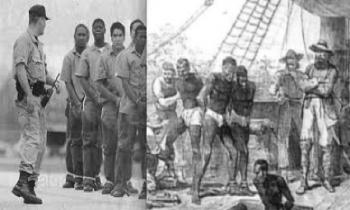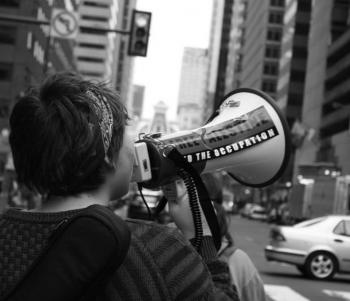Serendip is an independent site partnering with faculty at multiple colleges and universities around the world. Happy exploring!
jo's blog

silence and understanding
I made a video for my third web event: http://www.youtube.com/watch?v=bN0L1_vP85Q

Schools, Prisons, and the War on Drugs in “Third-World USA” (VOICE PAPER #2)
My trip to see mountaintop removal coal mining in southern West Virginia gave me a new perspective of the connection between schools and prisons that parallels discussions we've had in class about the war on drugs and over-surveillance, and the ways in which public schools set certain students up for failure and oppression by the system. I hadn't expected to see such a connection, as I, like many, have a tendency to forget that all issues of oppression are inherently connected and stem from upper-class white male control as it dominates society; to see that the schools are about as confining and the war on drugs about as harsh in these poor, white, rural Appalachian communities as they are in the poverty-ridden, predominately black inner cities. In looking at the various images we all posted last week, HSBurke’s pictures particularly hit me, one of a man standing against the bars of his prison cell, the other of a little boy standing similarly against the bars of the school yard fence. Both people were white, which really made me think of how the over-surveillance in “third world USA” (WV) is less an issue of race than class.

Angela Davis on abolition of slavery and prisons

 "We can do much more to combat the prison-industrial complex which is ravishing our communities if we recognize its historical connection with slavery and look at the nineteenth-century abolitionist movement as an inspiration for a late twentieth-century abolitionist movement that will work to reduce and ultimately abolish the use of imprisonment as the main means of addressing (or rather not addressing) social problems that are rooted in racism and poverty." Angela Davis, from her essay "Prison Abolition" in Black Genius: African American Solutions to African American Problems (p.203)
"We can do much more to combat the prison-industrial complex which is ravishing our communities if we recognize its historical connection with slavery and look at the nineteenth-century abolitionist movement as an inspiration for a late twentieth-century abolitionist movement that will work to reduce and ultimately abolish the use of imprisonment as the main means of addressing (or rather not addressing) social problems that are rooted in racism and poverty." Angela Davis, from her essay "Prison Abolition" in Black Genius: African American Solutions to African American Problems (p.203)

DIscovering Dominga
I watched this movie almost 3 years ago when I first visited Guatemala, and it shook me to my core. I know our classes are already really intense and heavy, but I just requested this from Magill at Haverford and if folks want to watch it with me I'd love to have a movie night (maybe this weekend?). As I remember it gives a really good background of the Guatemalan Civil War and why it happened, which I think would be helpful for us to be aware of in our discussions of Rigoberta Menchú.
http://www.pbs.org/pov/discoveringdominga/

(why are titles required?)
Silence feels a whole lot more complicated than it did when I wrote my first paper on the images of protest that Esty used to represent silence, and the difference between my feelings and thoughts about silence now and the image I posted three weeks ago of the moonrise, my image of silence, is huge. Over the summer, because I was alone in a country where I did not speak the language fluently, I became accustomed to silence, and though I hated and feared it at first, I grew to appreciate it, even need it to some degree. That, I suppose, is where the calm, peaceful image of space comes from.
Since then, I’ve begun to see silence everywhere and nowhere, to relish breaks in conversations or class discussions even as my skin crawls from the discomfort, to take out my headphones as I walk so that I can better hear the silence and noise of my mind. There are so many ways to conceptualize silence and so many judgments to be made; is it good or bad? A privilege or oppression? A presence or an absence? I have come to see that it is all of these things and more, though I’ve yet to show whether or not I can articulate my feelings. “How would you now visualize-and-vocalize silence?” The visualization is not so hard, but the vocalizing, the explanation, being coherent…that’s where I often stumble and retreat to silence.

silencing myself
You'll notice this post is quite late. And I didn't forget. Maybe I did procrastinate a bit, but then when I sat down to write the post, I just couldn't do it. I was already somewhat overwhelmed by the small amount of the texts I had read, and feeling anxious about what I would write. I began scrolling through other posts, hoping to find something to which I could respond, but I found myself growing even more overwhelmed. The posts were great, and very insightful, but the sheer bredth of topics sent my mind and my thoughts in several different directions and I couldn't really follow any of them.

a Vision of Silence and Voice
 I really wanted to use a picture of myself for this but didn't necessarily want it to show my face very clearly. I chose this for that reason and also because of what it shows about my voice/silence in a protest setting, something that is very important to me and has been an instrumental part in me finding my voice (as I wrote about in my last silence post). I also like that it is in black and white, especially after someone described silence as colorful in class and after reading the Little Book where Zehr recommends black and white fotography as a way to observe light. Also I just really like this picture :)
I really wanted to use a picture of myself for this but didn't necessarily want it to show my face very clearly. I chose this for that reason and also because of what it shows about my voice/silence in a protest setting, something that is very important to me and has been an instrumental part in me finding my voice (as I wrote about in my last silence post). I also like that it is in black and white, especially after someone described silence as colorful in class and after reading the Little Book where Zehr recommends black and white fotography as a way to observe light. Also I just really like this picture :)

Grace Marks, Celebrated Murderess
This summer I read a novel by Margaret Atwood called Alias Grace. It is based on the “celebrated murderess” Grace Marks a maid in Canada who was arrested for aiding and abetting the murder of her employer and the housekeeper in 1843. The novel is largely told from the point of view of both Grace and a doctor who listens to her in his study of criminal behavior, and in this way we hear her version of the story. The way Atwood retells it, Grace Marks is portrayed as someone who, not only suffered from poverty, a physically and emotionally absent mother, and an alcoholic and abusive father; she also was a victim of circumstances and was used by the farm hand who was hanged for the murd

Some disjointed thoughts (mostly about our class)
One thing I've been thinking a lot about since our class discussion on Tuesday is "imagined communities," the term my partner and I were given. It comes from the Pratt reading and was coined by Benedict Anderson. He says most human communities are imagined in that we give them traits that they don't actually possess, such as a feeling of finiteness and closeness among members. Though I think it is possible for communities to exist that really do have these qualities, I agree that more commonly, members of communities pretend their communities are the way they want them to be, giving them a false image of togetherness that ends up creating boundaries and forms an "other" where one might not have existed. This often results in contact zones (another term from this reading that we addressed a lot in class).
On an unrelated note, I found the disussion in the Freire and Shor reading particularly interesting with respect to our discussion in Silence class on Tuesday as well as our first Voice class. In one section they discuss the pressure to add to classroom discussion or dialogue, and it makes me think of what Ann said and then revised about not contributing to class discussion being selfish. Ira and Paulo explain that "In dialogue, one has the right to be silent" and that dialogical teaching does not necessarily mean everyone has to speak. That said, everything spoken in this class setting does contribute to the dialogue and therefore to the learning that takes place







